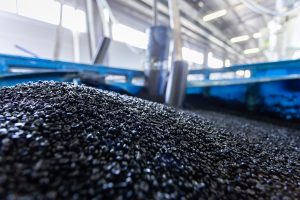
The biggest challenge of any factory or plant is material handling efficiency. How can you move massive amounts of material and prevent spoilage and waste? How do you get material to flow properly when it’s mixed and processed? How can you prevent material blocks that can stop production?
The reason material handling efficiency is so difficult is that materials have different flow properties. Some will settle during storage, or segregate when they’re mixed. Others will attract moisture and clump or cake. The sticky and dense formulas also have a tendency to cling to vessel walls and pipes.
Cohesive powders and solutions also present another problem: bridging and ratholing. Once these form in a vessel, the material flow slows down and even stops completely.
AirSweep improves material handling efficiency
Thousands of plants around the world trust AirSweep to solve these problems. AirSweep is a pneumatic flow aid that uses powerful air pulses to break up material blocks and push them back into the flow stream. It’s proven effective for even tough materials that other flow aids can’t handle.
Speed up production
Sluggish material flow affects all downstream processes and increases total production time. In many cases, workers even have to be pulled from other parts of the plant to manually clear the blocks.
Installing AirSweep can significantly speed up production. A minerals processing plant handles 120,000 tons of material a year. However, the powders and pebbles would plug the outlets. It took them an hour to fill just one supersack.
With AirSweep in place, material flowed quickly and reliably—cutting the filling of supersacks from one hour to two minutes. That’s a 3000% increase in production! The company eventually hired more people to keep up with the higher material flow.
Enable product innovation
Companies are always trying to improve their product. However, changing any component in a product formula can introduce new problems in material handling efficiency.
An international paint company needed to use a new grade of titanium dioxide. However, the material, which had finer and lighter particles, had a tendency to bridge above the feeder system and on the pneumatic transport vessels.
When AirSweep was installed in those problematic areas, it was able to clear out blocks and ensure on-demand flow. This reduced the batch time to just 15 minutes.
Reduce material waste
Food industries have to meet very strict regulations on spoilage and contamination. So, poor material flow will often mean throwing away any compromised batches. In fact, a flax company had to toss out 40 pounds of mixture away a day and even have to pay to have it hauled away.
The company tried many flow aids, including vibrators and fluidizers. However, workers still ended up spending an hour each day clearing away clogged material. Poor material handling efficiency was wasting money and time.
After AirSweep, everything changed. The system solved 90% of the material retention problems, reduced waste, and improved production speed.
Ensure plant safety
Safety violations and risks can cost a business its license to operate and lead to thousands of dollars in fines. However, poor material flow can put workers at risk, especially if they have to manually clean out stuck material in a hazardous environment.
One of the world’s largest building materials companies had issues with hot cement clinker plugging up vessels and chutes. Workers had to break up the material with bars and hammers, but this unnecessarily exposed them to chemicals and dust.
After installing AirSweep, they never had issues with clogged clinker. It improved production, but more importantly, ensured the safety of the workers.
AirSweep is proven to improve material handling efficiency
AirSweep is used in every industry and in every continent except Antarctica. Go to our case studies page to find more stories of how it has helped companies increase production, reduce waste, lower cost, and improve product quality and plant safety.





Comments are closed